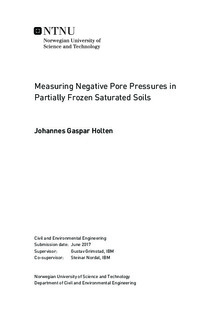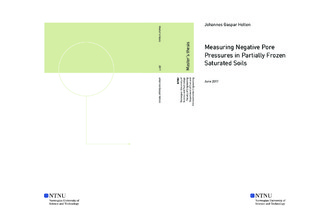| dc.description.abstract | Freezing of soil is an issue which has many implications on modern infrastructure, in which frost heave plays a pivotal role. During freezing the behavior of the soil and the flow of water is altered. In an engineering perspective, it is important to grasp the driving forces behind these behavioral changes. The main contributor to frost heave is the development of a large negative pore pressure in the unfrozen water in partially frozen fine-grained soil, termed cryosuction. The suction leads to an inflow of water to the frozen areas. It is important to be able to estimate the cryosuction to predict the inflow of water, and to quantify its impact on the stress state in the soil.
In this thesis, an apparatus has been constructed for measurements of pressure change in a saturated soil column exposed to one-dimensional unsteady heat flow, called a freezing cell. The cell is designed, built and tested at the Geotechnical Division at the Norwegian University of Science and Technology. The freezing cell consists of four pressure sensors and temperature transducers. The cell was tested in an ice lab holding -3$C, and was heated from the bottom up by a cryostat holding +4C. Multiple tests were performed using the cell, in which three yielded complete results. All tests showed good continuity in the water phase through the sample, as a clear communication of pressure were present.
The soil used for testing was a silt. 6% of the material was larger than 0.074 mm, and 2.5% was smaller than 0.002 mm. The soil was deemed to be medium to very frost susceptible by inspecting mineralogy, grain-size distribution, void ratio and overburden pressure.
The measured pressure change is the macroscopic pressure, which correlates to the suction in the thin water films adsorbed by ice and soil particles through the unfrozen water content. The largest measured suction is 8.5 kPa. Adjusted for unfrozen water content, with an estimated unfrozen water content of 10%, this equals approximately 85 kPa of cryosuction. The theoretically estimated suction is 560 kPa, which yields a large gap between calculated and measured suction. It is noted that the measured suction of 8.5 kPa equals a pressure reduction of almost 1 meter water column height, which in engineering terms is very significant, even though it is lower than the expected value.
The sample size of tests performed in this thesis is quite small as only three tests has been successfully performed. However, the general trend in the results from the tests are promising, and further tests should be performed with the cell to properly evaluate its ability to measure the cryosuction. | |

